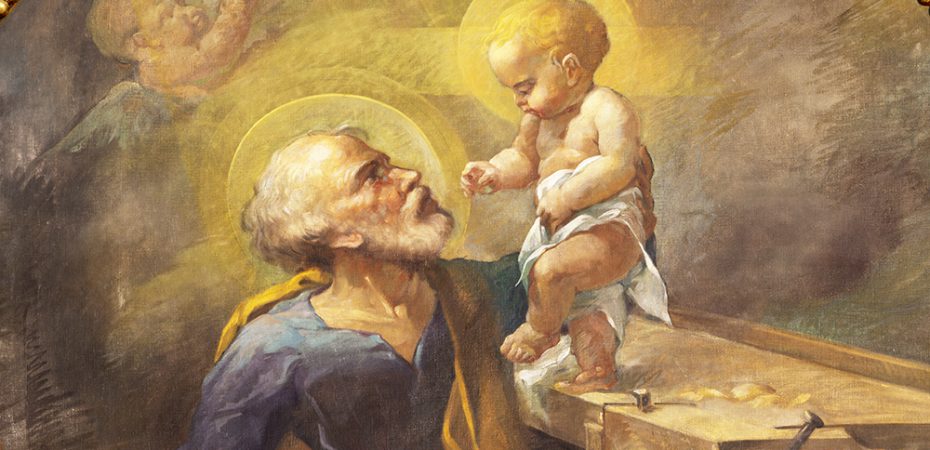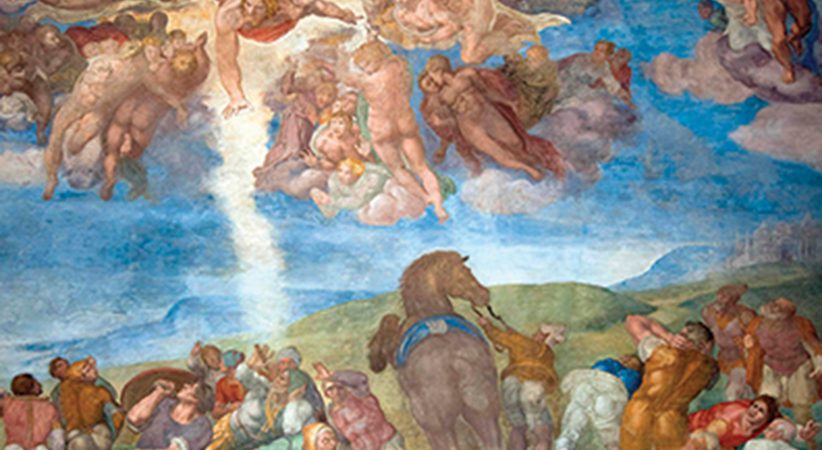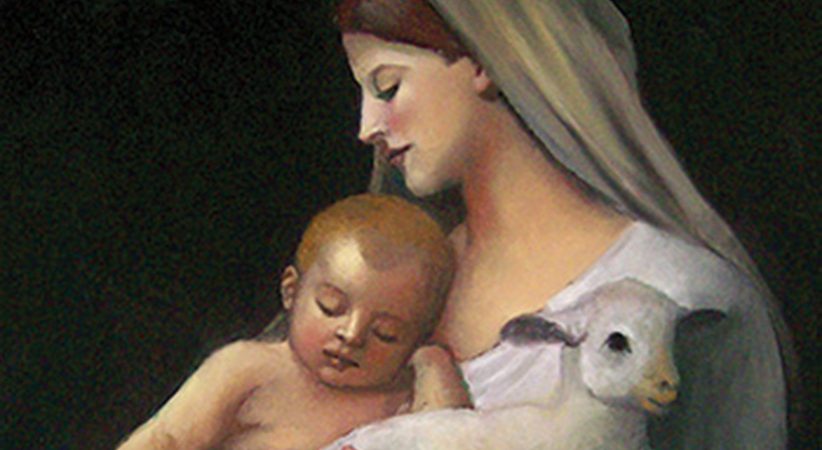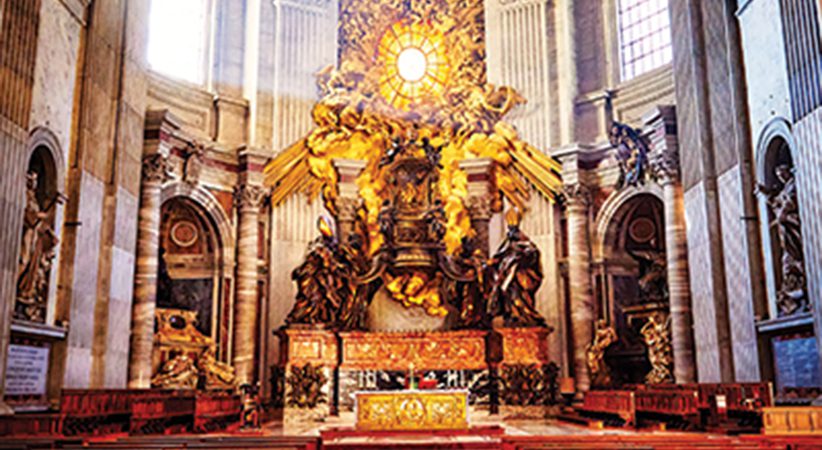From the Shadows
While the Scriptures lack a detailed depiction of St. Joseph, his role as a father has much to teach us
Father Ronald D. Witherup Comments Off on From the Shadows
On Dec. 8, 2020, Pope Francis surprised the world once more by issuing an apostolic letter declaring the “Year of St. Joseph.” I can imagine that no small numbers of bishops and priests were thinking, “Yet another themed year!”
Some dioceses had already planned their own themed events, some revolving around synods or diocesan planning. Moreover, shortly after the announcement, the Roman Curia’s Dicastery for Laity, Family, and Life also proclaimed an overlapping Year “Amoris Laetitia Family,” to commemorate the fifth anniversary of the post-synodal apostolic exhortation Amoris Laetitia and to bolster the image of the family at a time when it is threatened by many different forces.
While I am sympathetic to themed-year fatigue — not to mention pandemic fatigue that was gripping the world when the pope’s announcement was made — I think there is something worthwhile in a year devoted to St. Joseph that might prove beneficial on a parochial level. That is the focus of this article.
Patris Corde – The Apostolic Letter
To begin, let’s briefly review some key points related to the pope’s surprise announcement in this letter, “With a Father’s Heart.” The ostensible occasion for this year was the 150th anniversary of Joseph being proclaimed patron saint of the universal Church, which Pope Pius IX declared on Dec. 8, 1870.
Pope Francis explained, “I would like to share some personal reflections on this extraordinary figure, so close to our own human experience.” While Pope Francis’ devotion to St. Joseph is inspired by the sacred Scriptures, he also points out that detailed scriptural information on Joseph is lacking. That is why Joseph remains very much a saint “in the shadows,” which the pope freely acknowledges (cf. No. 7).
The main content of the letter, however, explains six other aspects of this saint, all of which are connected to his role as “father.” This is the main thrust of the pope’s teaching. The themes he emphasizes are Joseph as a father who is beloved, tender and loving, obedient, accepting, creatively courageous and hardworking. Coupled with the observation of Joseph as a hidden father figure, these seven themes provide the content of the apostolic letter and form a forceful summary of Francis’ conception of fatherhood in our day.
To round out his proclamation, Francis also provides a beautiful and concise new prayer to this saint, which should be prayed regularly throughout the year (see inset).
Popular Devotion
For all his obscurity, St. Joseph has nonetheless been a popular saint in the traditions of various peoples. Many cultures still foster devotion tohim, and this has led to some rather fanciful traditions.

One of the more curious customs surrounding St. Joseph was especially popular among some Italian families I knew. Some of them insisted that if you wanted to sell your house, all you needed to do was place a statue of St. Joseph upside down in a hole in your backyard, and it would sell. Of course, I consider this a superstition. But who knows? Since I never tried it, who am I to object?
Pope Francis pointed out another time-honored tradition rooted in the Church’s liturgy. Joseph’s name stands out in the Roman Canon (Eucharistic Prayer I), though it was absent in other canons that were either restored or composed in the wake of the Second Vatican Council. Early in his papacy, Pope Francis ordered that Joseph’s name be placed in the other Eucharistic canons, as well. We now recall this “most chaste” spouse of the Blessed Mother who warrants a special remembrance among the saints of heaven.
Biblical Context
Biblically, it would be an understatement to consider St. Joseph a hidden figure in the New Testament. He speaks not one word in any of the Gospels. He is not even named in the Gospel of Mark, the earliest of the four. In the other three Gospels, he is acknowledged as Jesus’ father (Jn 1:45; 6:42) and husband of Mary (Mt 1:16, 19).
| Pope Francis’ Prayer To St. Joseph |
|---|
|
Hail, Guardian of the Redeemer,
Spouse of the Blessed Virgin Mary. To you God entrusted his only Son; in you Mary placed her trust; with you Christ became man. Blessed Joseph, to us too, |
He is also said to be a carpenter (Greek: tektōn), which we might consider a trained artisan (Mt 13:55), someone who did woodworking for a living. Importantly, Joseph hails from the “house of David” (Lk 1:27) and thus carries the proper lineage to bestow on his son as Messiah.
The Gospel that portrays Joseph in his most active role is Matthew. Like his namesake in the Old Testament, this Joseph is closely connected to dreams (Mt 1:20; 2:13, 19). He is the recipient of these divinely directed messages that help him save his wife and child from a wicked king (Herod the Great). He takes them to Egypt to escape this jealous, murderous tyrant who is threatened by this newborn “king of the Jews” so that, like Israel of old, Jesus could come out of Egypt to be the savior (cf. Mt 2:15; Hos 11:1).
Joseph’s role in Jesus’ infancy narrative according to Matthew can rightly be considered comparable to Mary’s Annunciation story in Luke’s Gospel (Lk 1:26-38). Yet, as the late Sulpician scholar Father Raymond E. Brown once pointed out, unlike Mary’s famous scene, few artists have portrayed these “annunciations” to Joseph in their art. He remains in the background.
Focus on Fatherhood
This limited biblical data notwithstanding, Joseph plays an important role in the story of Jesus of Nazareth, which Pope Francis highlights in his apostolic letter. For me, two issues stand out.
The first concerns Joseph’s role as “father” to Jesus, which Francis rightly emphasizes. The New Testament makes it very clear that the true “Father” of Jesus is God (cf. Mt 1:20) and that Joseph’s role is that of a foster father (Lk 3:23). Joseph’s actions, however, as recounted in the Gospels, show him acting in all the right ways as a true, devoted “father” to Jesus. In the Matthean view, Joseph is a “righteous” man who, even before Jesus’ birth, has the proper intention not to embarrass Mary by a public divorce because of her unexplainable pregnancy ( Mt 1:19). Moreover, he protects both the child and his mother, fleeing from harm when necessary and only returning to their native home when the coast is clear.
Even more importantly, although details are never evoked, Joseph quite apparently provided for his little family by his woodworking. As a carpenter, he also apparently taught his son to follow in his steps (cf. Mk 6:3; Mt 13:55).
Joseph’s heritage in the line of David provided yet another important aspect to Jesus’ own identity. The Davidic line of kings in Israel was essential in messianic theology. Matthew highlights this lineage already through his genealogy of Jesus that revolves around King David, Israel’s archetypical king (cf. Mt 1:1-17). Jesus is also hailed as “Son of David” (Mt 1:1; 9:27; 20:30), one of the Christological titles highlighted by Matthew associated with Jesus’ healing ministry. So, Joseph provides a direct link to royal ancestry.
Pope Francis’ letter emphasizes these and other aspects of Joseph’s fatherhood that are worthy of reflection. When one recalls the Catholic practice of addressing priests as Father, we are asserting a metaphorical role that is vital in the family of faith. Paternity is not merely a question of biological identity. Fatherhood can be much broader than that, as seen in St. Paul’s practice of viewing himself as a spiritual “father” to his communities and even his younger coworkers (cf. 1 Cor 4:15; Phil 2:22).
Today, psychologists draw attention to the vital role fathers play in role-modeling for children, especially boys. Sadly, we live in an era where many families, especially among the poor, lack a stable father figure. Drawing attention to the ideal of real fatherhood is a value we should be promoting, and which can be a focus during this Year of St. Joseph. For priests especially, this might allow us to hone our skills as good spiritual father figures for the communities we serve.
Silence and Humility
The second aspect of Joseph that stands out from a biblical angle is the value of silence and humility. In a world bombarded with images of power and might, bullying and aggressiveness, shouting and haranguing, and a philosophy that getting ahead means stepping on the backs of others, we could use a dose of something else.
For someone who says not a word in the Gospels, Joseph’s silence speaks volumes. One might have expected him to rail against a tyrant like Herod, or to boldly fight off his enemies. Instead, what we see is quick action to protect his threatened family and then going about life in apparently a simple, unassuming manner. No need for machismo here!
Pope Francis once more picks up on this aspect of the image of Joseph with an appropriate comment: “A superficial reading of these stories can often give the impression that the world is at the mercy of the strong and mighty, but the ‘good news’ of the Gospel consists in showing that, for all the arrogance and violence of worldly powers, God always finds a way to carry out his saving plan” (Patris Corde, No. 5).
……………………………………………………………………………………………………………………………………………………………
PROTECTOR
“God trusted Joseph, as did Mary, who found in him someone who would not only save her life, but would always provide for her and her child. In this sense, St. Joseph could not be other than the Guardian of the Church, for the Church is the continuation of the Body of Christ in history, even as Mary’s motherhood is reflected in the motherhood of the Church. In his continued protection of the Church, Joseph continues to protect the child and his mother, and we too, by our love for the Church, continue to love the child and his mother.”
— Pope Francis, Patris Corde, No. 5.
……………………………………………………………………………………………………………………………………………………………
For people of faith, neither might nor simply being vocal counts the most. Silence is more than just not having something to say. It also fosters the skill of listening. Silence is an essential way to wait and listen carefully for the voice of God. Like Joseph, divine messages may well come in dreams. Or they may arrive in a sudden, unexpected insight. The most important lesson to be learned is that we do not always have to speak our mind, much less shout aloud, at every moment or in every circumstance. This is indeed one of the dangers of social media in our day, especially when people mistakenly believe it cloaks them in exculpatory anonymity.

The silence of Joseph naturally and unsurprisingly led some Christians to desire more information about him, especially when early devotion to his memory began, such as in the Eastern Church. The apocryphal “History of Joseph the Carpenter” appeared as early as the fourth century, and fanciful details of his life sprang into being. Such legends were perhaps unnecessary, though they filled a void to know more about this curious figure in Jesus’ life.
Devotion to St. Joseph seems to have developed quite naturally as time went on. It reached a peak in Church history in the 17th-century French school of spirituality, which is part of my own Sulpician tradition. Members of the French school such as St. Jean Eudes and Sulpician Father Jean-Jacques Olier developed a strong affinity for the image of St. Joseph, emphasizing his fatherly role in relation to the Holy Family. Father Olier even developed a special litany to this saint to be used on special feast days.
In our day, two main feasts for Joseph stand out — March 19 and May 1. The former is dedicated to Joseph, Husband of Mary, while the latter celebrates Joseph the Worker. The first focuses on his role as the devoted spouse of Mary and a selfless family man, while the second emphasizes his simple status as an artisan. The May 1 feast was instituted by Pope Pius XII in 1955, in part to combat the influence of modern labor movements that had secularized that day devoted to common laborers.
This Year of St. Joseph gives us yet another opportunity to praise God for this unassuming and humble saint who still offers a good model for fathers — literal or metaphorical — in our day.
SULPICIAN FATHER RONALD D. WITHERUP is Superior General of the Society of Saint Sulpice and author of many books on Scripture and theology, including “Gold Tested in Fire: A New Pentecost for the Catholic Priesthood” (Liturgical Press, $16.95) and “Scripture and Tradition in the Letters of Paul” (Paulist, May 2021).





